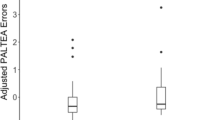Abstract
Donepezil (Aricept®), a long-acting cholinesterase inhibitor, is widely used in the treatment of Alzheimer’s disease to improve cognition and memory. Many drugs within the class of cognition-enhancing agents, both currently approved medications and those under development, have clinical indications narrowly relegated to Alzheimer’s disease. The purpose of this study was to determine whether the efficacy attributed to donepezil in its ability to improve delayed matching accuracy by monkeys was independent of age. Male and female rhesus monkeys (n=17) ranging from 9 to 29 yr of age were administered donepezil (10, 25, 50, and 100 µg/kg, im) during 4 discrete test days. Donepezil treatment improved average task accuracy, but intersubject variability prohibited statistical significance. When animals were considered individually, the most effective dose of donepezil was associated with a highly significant increase in group task performance that was consistent with enhanced recall during testing. The variability associated with the dose-response analysis was attributable primarily to subject age, such that older monkeys required higher doses of donepezil. Yet at doses that were effective in all subjects, there was no relationship between age and the improvement in task accuracy. Likewise, there was no association between baseline task proficiency and improvement in task accuracy.
Similar content being viewed by others
References
Anand R., Hartman R., Sohn H., Danyluk J., and Graham S. M. (2003) Impact of study design and patient population on outcomes from cholinesterase inhibitor trials. Am. J. Geriatr. Psychiatry 11, 160–168.
Bartus R. T. (2000) On neurodegenerative diseases, models, and treatment strategies: lesions learned and lessons forgotten a generation following the cholinergic hypothesis. Exp. Neurol. 163, 495–529.
Bigl V. and Schliebs R. (1998) Simulation of cortical cholinergic deficits—a novel experimental approach to study pathogenetic aspects of Alzheimer’s disease. J. Neural Transm. Suppl. 54, 237–247.
Boast C. A., Walsch T. J., and Bartolomeo A. (2001) The delayed non-match-to-sample radial arm maze task: application to models of Alzheimer’s disease, in Methods of Behavior Analysis in Neuroscience, Buccafusco, J. J., ed., CRC Press, New York, pp. 141–152.
Braida D. and Sala M. (2001) Eptastigmine: ten years of pharmacology, toxicology, pharmacokinetic, and clinical studies. CNS Drug Rev. 7, 369–386.
Buccafusco J. J. and Terry A. V., Jr. (2000) Multiple CNS targets for eliciting beneficial effects on memory and cognition. J. Pharmacol. Exp. Ther. 295, 438–446.
Buccafusco J. J. and Terry A. V., Jr. (2002) Nicotine and cognition in young and aged non-human primates, in Nicotine and the Nervous System, Levin, E., ed., CRC Press, New York, pp. 179–197.
Buccafusco J. J., Jackson W. J., Jonnala R. R., and Terry A. V., Jr. (1999) Differential improvement in memory-related task performance to nicotine by aged male and female rhesus monkeys. Behav. Pharmacol. 10, 681–690.
Buccafusco J. J., Jackson W. J., Stone J. D. and Terry A. V., Jr. (2003) Sex dimorphisms in the cognitive-enhancing action of the Alzheimer’s drug donepezil in aged rhesus monkeys. Neuropharmacology 44, 381–389.
Cummings J. L. (2003) Use of cholinesterase inhibitors in clinical practice: evidence-based recommendations. Am. J. Geriatr. Psychiatry 11, 131–145.
Davis K., Mohs R., Tinklenberg J., Pfefferbaum A., Hollister L., and Kopell B. (1978) Physostigmine: improvement of long-term memory processes in normal humans. Science 201, 946.
Furey M. I., Pietrini P., and Haxby J. V. (2000) Cholinergic enhancement and increased selectivity of perceptual processing during working memory. Science 290, 2315–2319.
Giacobini E. (2000) Cholinesterase inhibitors stabilize Alzheimer’s disease. Ann. N. Y. Acad. Sci. 920, 321–327.
Green R. C. (1995) Alzheimer’s disease and other dementing disorders in adults. Clin. Neurol. 3, 1–83.
Janus C. and Westaway D. (2001) Transgenic mouse models of Alzheimer’s disease. Physiol. Behav. 73, 873–886.
Michel B. F., Estadieu M. C., Gueriot C., Berthezene P., Allain H., Bongrand M. C., et al. (2001) Long-term treatment of Alzheimer’s disease: followup of a cohort of 255 patients treated with tacrine for four years. Rev. Neurol. (Paris) 157, 1365–1375.
Muir J. L. (1997) Acetylcholine, aging, and Alzheimer’s disease. Pharmacol. Biochem. Behav. 56, 687–696.
Paule M. G., Bushnell P. J., Maurissen J. P. J., Wenger G. R., Buccafusco J. J., Chelonis J. J., et al. (1998) Symposium overview: the use of delayed matching-to-sample procedures in studies of short-term memory in animals and humans. Neurotoxicol. Teratol. 20, 493–502.
Riekkinen P., Jr., Schmidt B. H., and van der Staay F. J. (1998) Animal models in the development of symptomatic and preventive drug therapies for Alzheimer’s disease. Ann. Med. 30, 566–576.
Ruske A. C. and White K. G. (1999) Facilitation of memory performance by a novel muscarinic agonist in young and old rats. Pharmacol. Biochem. Behav. 63, 663–667.
Terry A. V., Jr., and Buccafusco J. J. (2003) The cholinergic hypothesis of age and Alzheimer’s disease-related cognitive deficits: recent challenges and their implications for novel drug development. J. Pharmacol. Exp. Ther. 306, 821–827.
Terry A. V., Jr., Jackson W. J., and Buccafusco J. J. (1993) Effects of concomitant cholinergic and adrenergic stimulation on learning and memory performance by young and aged monkeys. Cereb. Cortex 3, 304–312.
Terry A. V., Jr., Risbrough V., Buccafusco J. J., and Menzaghi F. (2002) Effects of (±)-4-[[2-(1-methyl-2-pyrrolidinyl)ethyl]thio]phenol hydrochloride (SIB-1553A), a selective ligand for nicotinic acetylcholine receptors, in tests of visual attention and distractibility in rats and monkeys. J. Pharmacol. Exp. Ther. 301, 284–292.
Woodruff-Pak D. S. and Trojanowski J. Q. (1996) The older rabbit as an animal model: implications for Alzheimer’s disease. Neurobiol. Aging 17, 283–290.
Author information
Authors and Affiliations
Corresponding author
Rights and permissions
About this article
Cite this article
Buccafusco, J.J., Terry, A.V. Donepezil-induced improvement in delayed matching accuracy by young and old rhesus monkeys. J Mol Neurosci 24, 85–91 (2004). https://doi.org/10.1385/JMN:24:1:085
Issue Date:
DOI: https://doi.org/10.1385/JMN:24:1:085




